| disease | Primary Mediastinal Tumor (Surgical) |
| alias | Primary Mediastinal Tumor |
Primary mediastinal tumors are not uncommon. According to a report from Shanghai Chest Hospital involving 1,228 cases of mediastinal tumors, thymoma was the most common, followed by neurogenic tumors and teratomas. Other types such as cysts, intrathoracic thyroid, and bronchogenic cysts were relatively rare. Most of these tumors are benign but have the potential for malignant transformation.
bubble_chart Clinical Manifestations
The mediastinum is located in the center of the thoracic cavity. It extends from the thoracic inlet above to the diaphragm below, bounded laterally by the mediastinal pleura, and anteriorly and posteriorly by the sternum and thoracic vertebrae, respectively. The region above the level of the sternal angle is referred to as the superior mediastinum. The area anterior to the pericardium is called the anterior mediastinum, the area containing the pericardium is the middle mediastinum, and the area between the pericardium and the spine is the posterior mediastinum (Figure 1). Common mediastinal tumors have their predilection sites (Figure 2), which is clinically significant for diagnosis.
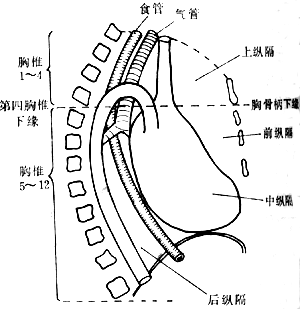
Figure 1: Division of the mediastinum
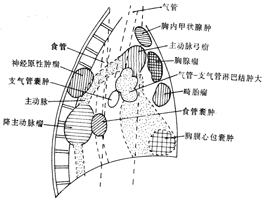
Figure 2: Main locations of mediastinal tumors
(1) Superior mediastinal tumors The most common are thymomas and intrathoracic thyroid tumors.
1. Thymoma Mostly located in the anterior superior or anterior middle mediastinum, accounting for about 1/4 to 1/5 of primary mediastinal tumors, with equal incidence in males and females. 30% are malignant, 30% are benign, and 40% are potentially or low-grade malignant. Benign cases are often asymptomatic and occasionally discovered during X-ray examination. If the tumor is small and densely adherent to the posterior sternum, it may be difficult to detect on X-ray. Thymomas are often adjacent to the ascending aorta, so significant transmitted pulsation may be observed. Histologically, they can be classified into lymphocyte-predominant, epithelial-reticular cell, and mixed epithelial-lymphocyte types. The common benign thymoma, where epithelial and lymphocyte components predominate, may recur or metastasize if incompletely resected. Zhongshan Hospital in Shanghai reported 12 cases of thymoma, 5 of which showed obvious malignancy during surgery, suggesting that thymomas should be considered low-grade malignant tumors requiring postoperative radiotherapy. Malignant thymomas tend to invade surrounding tissues, causing varying degrees of retrosternal pain and dyspnea. Advanced-stage patients may develop symptoms due to vascular or nerve compression, such as superior vena cava syndrome, diaphragmatic paralysis, or hoarseness. About 10-75% of thymoma patients may exhibit symptoms of myasthenia gravis, but only 15-20% of myasthenia gravis patients have thymic lesions. After tumor resection, about two-thirds of patients show improvement in myasthenia gravis symptoms. A few patients may develop aplastic anemia, Cushing's syndrome, lupus erythematosus, γ-globulin deficiency, or idiopathic granulomatous myositis. On X-ray, a round or oval mass is seen in the anterior superior mediastinum. Benign cases show clear, smooth contours with intact capsules and often cystic changes, while malignant cases exhibit irregular, rough contours and may be accompanied by pleural reactions. Surgical resection of thymomas yields good outcomes. Legg's analysis of 51 thymoma cases showed a 5-year survival rate of 23% for locally invasive tumors and 80% for non-invasive ones. Shanghai Chest Hospital reported a 5-year survival rate of 59.7% and a 10-year survival rate of 43.4% in 207 thymoma cases post-surgery.
2. Intrathoracic Goiter This includes congenital aberrant thyroid and acquired substernal thyroid. The former is rare, consisting of thyroid tissue remnants left in the mediastinum during embryonic development, which grow into thyroid tumors entirely located within the thorax without a fixed position. The latter refers to cervical thyroid tissue extending retrosternally into the anterior superior mediastinum (Figures 3A, B), mostly situated beside and in front of the trachea, with a minority located behind the trachea. Most intrathoracic goiters are benign, though individual cases may be adenocarcinoma. Traction or compression of the trachea by the mass may cause symptoms such as irritative cough and dyspnea. These symptoms may worsen when lying supine or turning the head and neck to the side. Compression of the thoracic muscles or spine can lead to chest tightness and back pain, and occasionally symptoms of hyperthyroidism may appear. If severe cough, hemoptysis, or hoarseness occurs, the possibility of malignant goiter should be considered. Approximately half of the patients may have a nodular goiter palpable in the neck. X-ray examination may reveal a shadow of a mass in the anterior superior mediastinum, oval or spindle-shaped, with clear margins, often deviating to one side of the mediastinum and sometimes bulging bilaterally. The presence of calcification in the tumor on plain films is diagnostically significant. In most cases, signs of tracheal compression and displacement, as well as upward movement of the tumor shadow during swallowing, can be observed.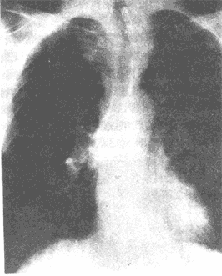
Figure 3A A retrosternal goiter located in the right upper mediastinum, with a wider upper end and a narrower lower end, slightly compressing the trachea (posteroanterior view).
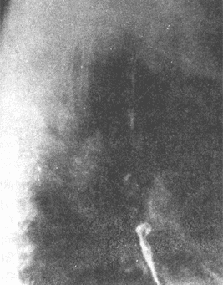
Figure 3B The retrosternal goiter extends downward and forward from the thoracic inlet into the retrosternal space (right lateral view).
(2) Anterior mediastinal tumors Tumors in the anterior mediastinum are most commonly teratomas. They can occur at any age, but symptoms appear in half of the cases between 20 and 40 years of age. Histologically, they are abnormalities or malformations of embryonic development. Teratomas can be divided into two types:
1. Dermoid cysts These are fluid-filled cysts containing tissues derived from the ectoderm, such as skin, hair, and teeth. They are usually unilocular but can also be bilocular or multilocular. The cyst wall is composed of fibrous tissue, lined with stratified squamous epithelium.
2. Teratomas These are solid mixed tumors composed of tissues from the ectoderm, mesoderm, and endoderm, including cartilage, smooth muscle, bronchi, pleura, neurovascular structures, and others. Teratomas have a higher tendency for malignant transformation compared to dermoid cysts, often developing into squamous cell carcinoma or adenocarcinoma. Literature reports 386 cases of teratomas, with 14.2% showing malignant changes. Among 10 teratomas at Zhongshan Hospital in Shanghai, 2 were malignant. Small tumors are often asymptomatic and usually discovered during X-ray examinations. If the tumor enlarges and compresses adjacent organs, corresponding symptoms may arise, such as superior vena cava syndrome from compression of the superior vena cava, hoarseness from recurrent laryngeal nerve compression, or dyspnea from tracheal compression, which worsens when the patient lies supine. If the cyst ruptures into a bronchus, the patient may cough up gelatinous fluid containing hair and sebum. Aspiration of this fluid into the lungs can lead to lipoid pneumonia and lipoid granulomas. Secondary infection of the cyst may cause fever and systemic toxic symptoms. Rapid enlargement of the cyst in a short period should raise suspicion of malignant transformation, secondary infection, or hemorrhage. If a suppurative cyst ruptures into the pleural cavity or pericardium, it can cause empyema or pericardial effusion.
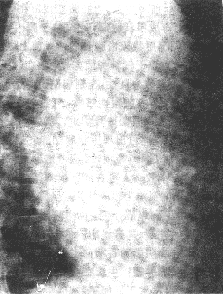
Figure 4 A teratoma containing bone fragments, teeth, and hair.
(3) Middle mediastinal tumors The vast majority are tumors of the lymphatic system, such as Hodgkin's disease, reticulum cell sarcoma, and lymphosarcoma. These are typically characterized by enlarged lymph nodes in the middle mediastinum but may also invade lung tissue, forming infiltrative lesions. The disease progresses rapidly, often accompanied by systemic lymphadenopathy, irregular fever, hepatosplenomegaly, and anemia. X-ray examination shows enlarged lymph nodes on both sides of the trachea and at the hila of the lungs. Markedly enlarged lymph nodes may fuse into masses with uniform density and lobulation but no calcification. The bronchi may appear narrowed or displaced.
(4) Posterior Mediastinal Tumors Almost all are neurogenic tumors. They can originate from spinal nerves, intercostal nerves, sympathetic ganglia, or vagus nerves, and may be benign or malignant. Benign types include schwannomas, neurofibromas, and ganglioneuromas; malignant types include malignant schwannomas and neurofibrosarcomas. Electron microscopy reveals that the ultrastructure of schwannomas and neurofibrosarcomas is similar, but their collagen content differs. The vast majority of neurogenic tumors are located in the paravertebral sulcus of the posterior mediastinum (Figures 5A, B), though they may occasionally be found elsewhere in the mediastinum, often encapsulated. Radiographic features include smooth, round, solitary masses. Large masses may widen the intercostal spaces or enlarge the intervertebral foramina. Sometimes, the tumor assumes a dumbbell shape, extending into the intervertebral foramen and invading the spinal canal, causing symptoms of spinal cord compression. Neurofibromas are more common in young adults and are usually asymptomatic. Larger tumors may produce compressive symptoms, such as pain between the scapulae or in the upper back, dyspnea, etc.
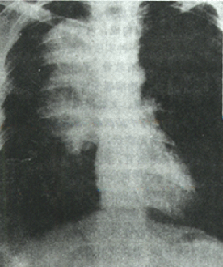
Figure 5A Mediastinal schwannoma The tumor is located in the right paravertebral region, presenting a bottle gourd peel appearance (posteroanterior view)
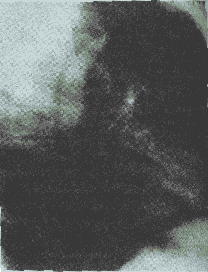
Figure 5B Mediastinal schwannoma The tumor is located in the posterior mediastinum, overlapping the thoracic vertebrae, showing a bottle gourd peel appearance (right lateral view)
(5) Bronchogenic cyst Can occur in any part of the mediastinum, mostly located near the trachea, bronchi, or carina. Bronchogenic cysts are mostly congenital, arising from tracheal aberrant buds, and are commonly seen in children under 10 years old. Usually asymptomatic, but if connected to the bronchus or pleura, a fistula may form. Secondary infection can lead to cough, hemoptysis, purulent sputum, or even empyema. X-ray examination reveals a round or oval, uniformly dense, well-defined mass shadow in the upper-middle mediastinum near the trachea or major bronchi, with lobulation or calcification. If the cyst communicates with the bronchus, an air-fluid level may be observed.
Mediastinal tumors can sometimes be difficult to distinguish morphologically from primary or secondary lung tumors, enlarged lymph nodes, hemangiomas, etc. Common examination methods are as follows.
(1) X-ray examination: If fluoroscopy reveals pulsation in the tumor, it should first be determined whether it is expansile or conductive pulsation. If it is the former, a stirred pulse tumor may be preliminarily suspected, and X-ray kymography or angiography can be used for confirmation. If an upper mediastinal tumor moves upward with swallowing during X-ray fluoroscopy, it may be preliminarily diagnosed as a thyroid tumor. X-ray plain films in frontal, lateral, and oblique views, tomograms, or high-kilovoltage films can clarify the tumor's location, shape, density, presence of calcification or ossification, etc., thereby providing a preliminary judgment of the tumor type. A barium swallow examination can determine whether the esophagus or adjacent organs are compressed.
(2) Fiberoptic bronchoscopy or esophagoscopy: Helps clarify the extent and degree of bronchial compression, whether the tumor has invaded the bronchus or esophagus, and thus estimate the feasibility of surgical resection.
(3) Diagnostic pneumothorax: Can determine whether the tumor originates from the chest wall or lung, or whether it is intra- or extrapulmonary. Diagnostic pneumoperitoneum can differentiate subdiaphragmatic factors, such as pulmonary hernia.
(4) Mediastinal pneumography: Quite helpful in displaying the morphology of anterior mediastinal tumors and determining the presence of mediastinal lymph node metastasis.
(5) Mediastinoscopy: Useful for identifying enlarged lymph nodes near the trachea or under the carina and for obtaining biopsy specimens to confirm disease cause diagnosis.
(6) Computed tomography (CT): CT is more reliable than any other X-ray method for examining anterior mediastinal masses, enlarged lymph nodes, and lesions of mediastinal fatty tissue (e.g., lipomas). The accuracy of CT in diagnosing mediastinal tumors and enlarged lymph nodes exceeds 90%.
(7) Magnetic resonance imaging (MRI): Offers the following advantages: multiple imaging parameters; high soft tissue resolution; flexible slice orientation; absence of bony artifacts; safety and reliability without ionizing radiation injury. It has unique value in diagnosing mediastinal tumors.
(8) Cervical lymph node biopsy: Bronchial lymph subcutaneous nodes and lymphomas often involve surrounding and cervical lymph nodes, and biopsy can aid in diagnosis.
(9) Radionuclide examination: For suspected intrathoracic goiter, radionuclide 131 iodine scanning can be performed, which is very helpful in diagnosing ectopic thyroid goiter and thyroid adenoma.
(10) Diagnostic radiotherapy: For suspected cervical malignancy with cachexia that cannot be confirmed by other examinations, radiotherapy may be attempted. Cervical malignancy with cachexia is relatively radiosensitive, and the tumor rapidly shrinks after irradiation with 20–30 Gy (2000–3000 rad).
(11) Thoracotomy: If the nature of the tumor cannot be determined through various examinations but cervical malignancy with cachexia has been ruled out, thoracotomy may be performed if the patient's overall condition permits.
bubble_chart Treatment Measures
For localized cervical malignancy with cachexia, radiation therapy can be performed. For extensive lesions, chemotherapy may be considered.
The primary treatment for other mediastinal tumors is surgical resection. Some mediastinal tumors, such as teratomas, neurofibromas, and thymomas, have the potential for malignant transformation, and postoperative adjuvant radiotherapy or chemotherapy should be administered.
1. Central lung cancer presents with respiratory symptoms such as cough and sputum production. X-ray findings show hilar masses, appearing semicircular or lobulated. Bronchoscopy often reveals the tumor, and tumor cells may be detected in the sputum.
2. Mediastinal lymph subcutaneous nodes are more common in children or adolescents and often have no clinical symptoms. A few cases may present with low-grade fever, night sweats, and other grade I toxic symptoms. Round or lobulated masses can be observed in the hilar region, often accompanied by pulmonary subcutaneous node lesions. In some cases, calcification spots may be seen in the lymph nodes. If differentiation is difficult, a subcutaneous node bacillus test or short-term anti-subcutaneous node drug therapy can be administered.
3. Main stirred pulse tumor is more common in older patients. Vascular murmurs may be heard during physical examination, and fluoroscopy may reveal expansile pulsations. Retrograde main stirred pulse angiography can confirm the diagnosis.






